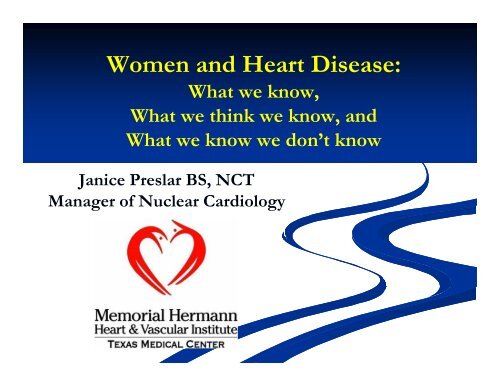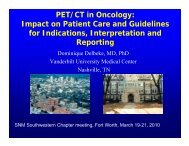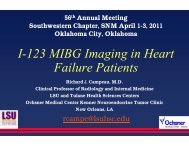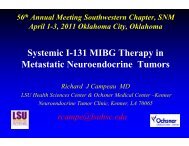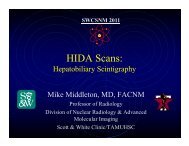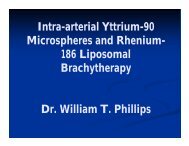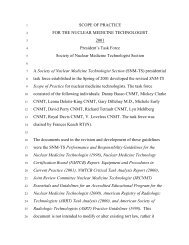Heart Disease in Women
Heart Disease in Women
Heart Disease in Women
You also want an ePaper? Increase the reach of your titles
YUMPU automatically turns print PDFs into web optimized ePapers that Google loves.
<strong>Women</strong> and <strong>Heart</strong> <strong>Disease</strong>:<br />
What we know,<br />
What we th<strong>in</strong>k we know, and<br />
What we know we don’t know<br />
Janice Preslar BS, NCT<br />
Manager of Nuclear Cardiology
Why is <strong>Women</strong>’s Health Important?<br />
• <strong>Women</strong> make up 51% of the population<br />
• 58% of persons 65 years and older are women<br />
• <strong>Women</strong> <strong>in</strong> the middle years (ages 45-64)<br />
comprise the largest population<br />
• 40% of the total American population<br />
• 75% of all caregivers are women<br />
• 2.3 M grandparents rais<strong>in</strong>g grandchildren<br />
• 63% are women
<strong>Heart</strong> <strong>Disease</strong> is the No.1 Killer <strong>in</strong><br />
<strong>Women</strong><br />
• 1 <strong>in</strong> 4.6 women died of cancer vs. 1 <strong>in</strong> 2.6 died of CVD<br />
• CVD caused about 1 death a m<strong>in</strong>ute among females<br />
• >460,000 female lives <strong>in</strong> 2004<br />
Chronic Lower<br />
Respiratory<br />
<strong>Disease</strong>s<br />
Diabetes<br />
Mellitus<br />
Influenza and<br />
Pneumonia<br />
Cancer<br />
Cardiovascular<br />
<strong>Disease</strong>s
Awareness Gap<br />
• 31% identified heart disease or stroke as the lead<strong>in</strong>g<br />
cause of death<br />
• 73% -- risk of develop<strong>in</strong>g HD by age 70 was
CV Mortality Trends
Why the Disparity?
Time to Treatment<br />
• <strong>Women</strong> wait longer than men to go to the ED<br />
when hav<strong>in</strong>g an ACS<br />
• Physicians are slower <strong>in</strong> recogniz<strong>in</strong>g ACS <strong>in</strong><br />
women than <strong>in</strong> men<br />
• 66% of ED and critical care cl<strong>in</strong>icians<br />
• Primarily assessed for CP <strong>in</strong> persons with<br />
suspected AMI
Different communication patterns<br />
• <strong>Women</strong> are more likely to give full account of<br />
symptoms whereas men tend to focus on what<br />
is problematic<br />
PAIN<br />
Fatigue, dyspnea,<br />
weakness, upset stomach,<br />
hip pa<strong>in</strong>, chest ache, etc.
Def<strong>in</strong>itions are Faulty<br />
• Normative standards for symptoms<br />
of ACS were set <strong>in</strong> men
Chest pa<strong>in</strong> symptoms<br />
are less accurate and less precise<br />
predictors of<br />
obstructive CAD <strong>in</strong> women
<strong>Women</strong> and ACS<br />
• M<strong>in</strong>ority present with chest pa<strong>in</strong> symptoms<br />
• 30% of women with ACS reported CP<br />
• More women present with constitutional symptoms<br />
rather than chest pa<strong>in</strong><br />
Milner et al, Am J Cardiol 1999; 84: 396.
<strong>Women</strong> with ACS<br />
• 95% reported prodromal symptoms<br />
• Unusual fatigue<br />
• Sleep disturbance<br />
• Shortness of breath<br />
• Indigestion<br />
• Anxiety<br />
• Prodromal symptoms were the most important<br />
predictor of acute coronary syndrome
67 yr. old female: Atypical CP<br />
• Risk Factors:<br />
DM,<br />
FH of CAD,<br />
Sedentary<br />
Overweight
Rest<br />
Stress<br />
Lateral<br />
Inferior Septal Anterior
Before<br />
After
Implications<br />
• More women are misdiagnosed and discharged<br />
from ER<br />
• More women have unrecognized AMI
Mortality after Unrecognized MI<br />
Unrecognized MI<br />
Recognized MI<br />
Sheifer et al, Ann Intern Med 2001.
Chest pa<strong>in</strong> symptoms<br />
are less accurate and less precise<br />
predictors of<br />
obstructive CAD <strong>in</strong> women
Coronary Atherosclerosis<br />
Bostrom et al, J Cl<strong>in</strong> Invest 1993.
Obstructive Angiographic CAD
Nonobstructive CAD Rates <strong>in</strong> ACS Trials<br />
Prevalence<br />
Rate (%)<br />
Anderson et al, Circulation 2007.
Nonobstructive Angiographic CAD<br />
Escolar et al, Can Med Assoc J 2006.
Gender Differences <strong>in</strong><br />
Arterial Remodel<strong>in</strong>g<br />
Constrictive Remodel<strong>in</strong>g<br />
Expansive Remodel<strong>in</strong>g
Gender Differences <strong>in</strong><br />
Arterial Remodel<strong>in</strong>g<br />
Nissen & Yock, Circulation 2001.
<strong>Women</strong> and CAD<br />
• >50% of women (vs. 15% men) with chest<br />
pa<strong>in</strong> undergo<strong>in</strong>g coronary angiography are<br />
found to have normal or near normal<br />
coronaries<br />
• MPI false positive or real ?
“False-positive” myocardial perfusion sc<strong>in</strong>tigraphy f<strong>in</strong>d<strong>in</strong>gs<br />
<strong>in</strong> patients with angiographically normal coronary arteries: 1<br />
• 20 patients studied with chest pa<strong>in</strong>, abnormal<br />
exercise ECG, abnormal MPI, and normal<br />
angiographic f<strong>in</strong>d<strong>in</strong>gs to exam<strong>in</strong>e the differences <strong>in</strong><br />
disease detection between three modalities<br />
1. Verna E, et al. J Nucl Med. 2000;41(12):1935–1940.
False-Positive? 1<br />
Repr<strong>in</strong>ted with permission from Journal of Nuclear Medic<strong>in</strong>e<br />
1. Verna E, et al. J Nucl Med. 2000;41(12):1935–1940.
Event Rate <strong>in</strong> Patients with<br />
“Nonobstructive CAD”<br />
Bugiard<strong>in</strong>i et al, Arch Intern Med 2006.
Event-free Survival from CV Events<br />
by CAD and Persistent Chest Pa<strong>in</strong><br />
*CAD def<strong>in</strong>ed as coronary stenosis ≥50%<br />
<strong>in</strong> at least 1 major epicardial coronary artery<br />
Johnson et al, Eur <strong>Heart</strong> J 2006.
Impact<br />
• Many women with ang<strong>in</strong>a are told that they do<br />
not have significant heart disease<br />
• May lead to worse adverse outcomes as<br />
diagnostic and treatment strategies are focused on<br />
identification of “obstructive” CAD<br />
• Offered no specific treatment other than<br />
reassurance
<strong>Women</strong> and Coronary Symptoms<br />
Ischemic mechanism<br />
related to coronary microvascular or macrovascular<br />
endothelial dysfunction
Abnormal Vascular Function<br />
• Seen <strong>in</strong> 47% of women with “normal” or “near<br />
normal” angiograms<br />
• 59% who had abnormal vasomotor response to ACh<br />
cont<strong>in</strong>ued to have CP and developed CAD on follow-up<br />
• <strong>Women</strong> with normal vasomotor response had complete<br />
resolution of symptoms at follow-up
Abnormal Vascular Function<br />
• Not well understood<br />
• Plays a central role <strong>in</strong> genesis of symptoms and<br />
ischemia <strong>in</strong> women<br />
• More prevalent <strong>in</strong> women and so places a woman<br />
at relatively higher risk than her male counterpart<br />
for any amount of CAD
Mental Stress-Induced<br />
Myocardial Ischemia<br />
• Young et al (1991) -- mental stress - paradoxical<br />
arterial vasoconstriction <strong>in</strong> diseased arteries.<br />
• Patients with CAD often show an exaggerated<br />
systemic response to stress.<br />
• Hemodynamic changes with mental stress occur<br />
suddenly as opposed to exercise.
Mental Stress-Induced<br />
Myocardial Ischemia<br />
• Known CAD, normal exercise or<br />
adenos<strong>in</strong>e stress nuclear test<br />
• Hemodynamic Changes<br />
• SBP: 130.1 ± 13mmHg to 190 ± 26mmHg<br />
• DBP: 76.8 ± 5mmHg to 103.2 ± 12mmHg<br />
• HR: 64.3 ± 9 bpm to 86 ± 14 bpm<br />
• N=21 – 29% had mental-stress <strong>in</strong>duced<br />
reversible perfusion defect<br />
Ramachandruni S et al, J Am Coll Cardiol 2006.
<strong>Women</strong> and Coronary Symptoms<br />
• How can vascular dysfunction be tested?<br />
Quantitative heart<br />
blood flow at rest and<br />
stress
Cardiac P.E.T.
<strong>Women</strong> and Coronary Symptoms<br />
• Is vascular dysfunction <strong>in</strong> the absence of<br />
flow limit<strong>in</strong>g stenosis a treatment target?<br />
• What treatment?
Aggressive Risk<br />
Factor Modification<br />
+<br />
Exercise Tra<strong>in</strong><strong>in</strong>g
Aggressive Risk<br />
Factor Modification<br />
Further Def<strong>in</strong>e Risks
• Fram<strong>in</strong>gham<br />
Risk Stratification<br />
Risk Scores<br />
• Age<br />
• LDL/Cholesterol<br />
• HDL<br />
• BP<br />
• DM<br />
• Smoker<br />
= 10 year risk<br />
Wilson et al, Circulation 1998.
Risk Stratification<br />
• Limitations of Fram<strong>in</strong>gham score<br />
• Based on white population<br />
• Did not take family history <strong>in</strong>to account<br />
• 40% of women with a family history of early CAD<br />
classified as low risk but had detectable coronary<br />
calcium<br />
• 12% had CAC >100, and 6% had CAC ≥ 400<br />
• 32% had significant subcl<strong>in</strong>ical atherosclerosis and<br />
17% ranked above the 90 th percentile
Risk Stratification<br />
• Reynolds Risk Score<br />
• Web based calculator that uses 6 questions relat<strong>in</strong>g to:<br />
• Age<br />
• Smok<strong>in</strong>g status<br />
• Systolic BP<br />
• Total cholesterol<br />
• High-density lipoprote<strong>in</strong> cholesterol (HDL)<br />
• C-reactive prote<strong>in</strong><br />
• Family history (mother or father hav<strong>in</strong>g a myocardial <strong>in</strong>farction<br />
before age 60 years)<br />
• Similar for low and high risk groups but faired better<br />
for <strong>in</strong>termediate risk groups.
10 Year Risk vs. Lifetime Risk<br />
Lloyd-Jones et al, Arch Intern Med 2003.
Lifetime Risk<br />
• Provide absolute risk assessment<br />
• May be more easily understood by patients and<br />
cl<strong>in</strong>icians<br />
• Help motivate lifestyle changes or behaviors
Lifetime Risk
Need to Consider Lifetime Risk<br />
<strong>in</strong> addition to Short-Term Risk
Exercise<br />
1/36.5 M hrs
How many miles would I have to<br />
run ?<br />
Sudden Death
Functional Capacity<br />
• Exercise capacity is an <strong>in</strong>dependent predictor of the<br />
risk of death and cardiac events among women and<br />
men<br />
• Functional capacity correlated well with outcomes<br />
• 67% of deaths or MI <strong>in</strong> women occurred with DASI<br />
scores
Exercise ECG Test<strong>in</strong>g<br />
• Developed and validated<br />
us<strong>in</strong>g a male population
Nomogram of the Percentage of<br />
Predicted Exercise Capacity for Age<br />
Gulati et al, NEJM 2005.
Physical Inactivity<br />
• Ranks second as the most important contributor to<br />
population ill-health<br />
• Ranks first as lead<strong>in</strong>g contributor to preventable illness and<br />
morbidity <strong>in</strong> women and second <strong>in</strong> men<br />
•<strong>Women</strong> are more likely<br />
to lead sedentary lifestyles<br />
than men<br />
Population Prevalence (%)<br />
40<br />
35<br />
30<br />
25<br />
20<br />
15<br />
10<br />
Men<br />
<strong>Women</strong><br />
5<br />
0<br />
2000 2003
Physical Inactivity<br />
• Inactivity <strong>in</strong>creases with age<br />
• Physical activity decl<strong>in</strong>es rapidly with age dur<strong>in</strong>g<br />
adolescence, especially among females<br />
• Among women age 18 and older, 40.6%<br />
sedentary (have no leisure-time physical activity)<br />
National Center for Health Statistics. Health 2006.
Risk Factors<br />
Predictive Power Varies by Sex
Depression and CAD<br />
45<br />
40<br />
35<br />
Men<br />
<strong>Women</strong><br />
30<br />
Percent<br />
25<br />
20<br />
15<br />
10<br />
5<br />
0<br />
or=60 years<br />
Malik et al, Arch Int Med 2006.
Depression and CAD<br />
• Strong predictor of adverse outcomes after ACS<br />
• Associated with worse patient health status and higher<br />
cost of care<br />
• Direct mechanism vs. behavioral<br />
• Physiology of depression (high sympathetic tone and high<br />
platelet aggregability)<br />
• Noncompliance with medications and lifestyle <strong>in</strong>terventions
Rate of depression among<br />
women with AMI under<br />
the age of 60 was 40%
Social Support<br />
• Associated with better survival after an AMI<br />
• Does marital status confer similar social support<br />
to men and women after AMI?
Marital Status ≠ Social Support<br />
<strong>in</strong> <strong>Women</strong>
Marital Status and Survival after AMI
<strong>Women</strong> with CAD<br />
• Depression screen<strong>in</strong>g is important, particularly<br />
among young women<br />
• Need to evaluate whether psychosocial<br />
<strong>in</strong>terventions for women after AMI can reduce<br />
observed disparities <strong>in</strong> outcomes
AHA 2007 Guidel<strong>in</strong>es for<br />
CVD Prevention <strong>in</strong> <strong>Women</strong>
The Good News
Awareness of CVD <strong>in</strong> <strong>Women</strong><br />
50<br />
45<br />
40<br />
Population (%)<br />
35<br />
30<br />
25<br />
20<br />
15<br />
<strong>Heart</strong> <strong>Disease</strong>/<strong>Heart</strong> Attack<br />
Cancer (General)<br />
Breast Cancer<br />
10<br />
5<br />
0<br />
1997 2000 2003<br />
Year of Survey
Awareness of CVD <strong>in</strong> <strong>Women</strong><br />
• Suggest that efforts<br />
to educate women<br />
have been successful<br />
Improved general awareness is associated with<br />
greater personal awareness and <strong>in</strong>creased<br />
actions to lower CVD risk
Recent CV Mortality Trends<br />
Rosamond et al, Circulation 2007.
AHA 2011 Guidel<strong>in</strong>es for<br />
CVD Prevention <strong>in</strong> <strong>Women</strong><br />
• Lowered threshold for “High Risk”-20% to 10%<br />
• “Real World” vs. Cl<strong>in</strong>ical Trials<br />
• Pregnancy complication<br />
• Aspir<strong>in</strong> <strong>in</strong> DM<br />
• DM control<br />
• Stat<strong>in</strong>s / C-reative prote<strong>in</strong>
Cl<strong>in</strong>ical Trials<br />
• Many early trials ma<strong>in</strong>ly focused on men<br />
• Now more women, oversampl<strong>in</strong>g of women,<br />
mandat<strong>in</strong>g <strong>in</strong>clusion of specific % women by<br />
NIH<br />
• Get more sex-specific data and evidence-based<br />
<strong>in</strong>formation<br />
• <strong>Heart</strong> for <strong>Women</strong> Act – requir<strong>in</strong>g gender<br />
<strong>in</strong>formation
The Bad News
Translation of Knowledge<br />
to Positive Behavior<br />
• AHA-GWTG and CRUSADE Database<br />
• Time from symptom onset to hospital presentation<br />
Diercks et al, Am <strong>Heart</strong> J 2010; 160: 80-87.
Cardiac Rehabilitation<br />
• Underused, particularly <strong>in</strong> women and the elderly<br />
• <strong>Women</strong> were 55% less likely than men to<br />
participate <strong>in</strong> cardiac rehabilitation
Physician Awareness<br />
Fewer than 1 <strong>in</strong> 5 physicians knew that more<br />
women than men die each year from CVD
Frequency of Use of Evidence-Based Medical<br />
Therapy After Presentation to a Cardiologist<br />
Medication Overall Male Female P<br />
Antiplatelet 81% 84% 76%
CAD and <strong>Women</strong><br />
The Myth Still Exists
Sex Matters<br />
• Every cell has a sex, so sex does matter<br />
• Sex affects behavior and perception<br />
• Sex affects health – different patterns of illness and<br />
different life spans<br />
• Dissimilar exposures, susceptibilities and responses to<br />
<strong>in</strong>itiat<strong>in</strong>g agents, variable responses to pharmacologic agents<br />
Sex is an important basic human variable that<br />
should be considered when design<strong>in</strong>g and<br />
analyz<strong>in</strong>g studies <strong>in</strong> all areas and at all levels of<br />
biomedical and health-related research
Gender-Based Disparities<br />
• S<strong>in</strong>ce 1984, more women than men have died annually<br />
from ischemic heart disease<br />
• <strong>Women</strong> with IHD have more adverse outcomes<br />
• Traditional disease management approaches that focus<br />
on obstructive coronary stenosis often fail to identify<br />
those women who are at risk
Gender-Based Disparities<br />
• Expand<strong>in</strong>g def<strong>in</strong>ition of the “typical” female<br />
coronary disease pathophysiology and presentation<br />
• Modify normative standards<br />
• Educate patients and healthcare professionals
• Further Study is Needed to Def<strong>in</strong>e Sex<br />
Differences <strong>in</strong> Atherosclerosis<br />
• Poor understand<strong>in</strong>g of the gender-specific<br />
differences <strong>in</strong> presentation and prognosis of heart<br />
disease<br />
• Studies for Gender Based Management<br />
Strategies<br />
• Future research should publish both efficacy and<br />
ADR by gender
Application of proven <strong>in</strong>terventions<br />
<strong>in</strong> day to day practice
Her Future
The New Face of <strong>Heart</strong> <strong>Disease</strong>


